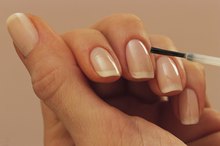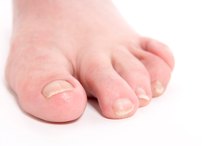What does fact checked mean?
At Healthfully, we strive to deliver objective content that is accurate and up-to-date. Our team periodically reviews articles in order to ensure content quality. The sources cited below consist of evidence from peer-reviewed journals, prominent medical organizations, academic associations, and government data.
The information contained on this site is for informational purposes only, and should not be used as a substitute for the advice of a professional health care provider. Please check with the appropriate physician regarding health questions and concerns. Although we strive to deliver accurate and up-to-date information, no guarantee to that effect is made.
If You Have White Nails, Does That Mean They Are Healthy?
Your nails are hard plates formed mainly from keratin, a protein that also exists in your hair. The primary function of your nails is to protect the sensitive areas of your fingers and toes. Healthy fingernails and toenails are most often clear. A white coloring of the nails might not be anything to worry about if you are otherwise healthy, but whiteness of the nails in certain locations can also indicate some underlying health conditions. If you're concerned that the coloring of your nails might indicate a health problem, see your doctor for a diagnosis.
Normal Nails
Healthy nails are colorless, except for a pale white half-moon shape at the bottom of the nail bed. Your nails might also appear white when they grow past your fingertips or toes. This pattern of white coloring is completely normal and no cause for concern. You also might see occasional white streaks or spots on your nails. This form of discoloration, when you and your nails are otherwise healthy, does not necessarily indicate poor health.
- Healthy nails are colorless, except for a pale white half-moon shape at the bottom of the nail bed.
- Your nails might also appear white when they grow past your fingertips or toes.
Drugs and Chemicals
What Causes Horizontal Ridges in Fingernails?
Learn More
Your nails might appear white in areas if you have been exposed to certain drugs or chemicals. Chemotherapy drugs used to fight cancer can cause you to develop white bands on your nails. Arsenic poisoning is another chemically induced reason for a white discoloration of the nails. In these cases, your nails are displaying signs that you are reacting to toxins within your body. Once the exposure to toxins has been removed -- your chemotherapy round is over, or you have been treated for high levels of arsenic -- your nails should clear up. Keep in mind that the white areas of your nails will remain until the affected section of nail has grown out of the nail bed.
- Your nails might appear white in areas if you have been exposed to certain drugs or chemicals.
Underlying Diseases
A number of chronic, underlying diseases can cause your nails to become white, but in many cases, the discoloration points to a medical condition that is unrelated to your nail health 1. Skin diseases such as psoriasis and vitiligo can cause white spots on your nails. The skin around your nails also whitens in response to vitiligo; your nails might be deformed and pitted in the case of psoriasis. Chronic kidney or liver disease can also manifest itself through your nails. Patients with severe cirrhosis or renal failure might notice the bottom half of their nails turn white, while the upper areas remain pink-to-clear.
- A number of chronic, underlying diseases can cause your nails to become white, but in many cases, the discoloration points to a medical condition that is unrelated to your nail health 1.
- The skin around your nails also whitens in response to vitiligo; your nails might be deformed and pitted in the case of psoriasis.
Nail Fungus
Signs of Kidney Disease in Fingernails
Learn More
Fungal diseases of the nail do not usually manifest themselves with a bright white discoloration, but rather a yellowy hue 1. Nails that are overtaken with fungi might appear thicker than usual, or become crumbly and brittle in texture. Fungal diseases do not heal on their own, but require the administration of either topical or oral antifungal medications.
Related Articles
References
- Dermnet NZ: Nail Diseases
- MedlinePlus: White Nail Syndrome
- Merck Manual: Nail Disorders: Deformities and Discolorations
- Lacouture, M., and V. Sibaud. Toxic side effects of targeted therapies and immunotherapies affecting the skin, oral mucosa, hair, and nails. American Journal of Clinical Dermatology. 2018. 19(Suppl 1):31-39. doi:10.1007/s40257-018-0384-3
- Ryu, H., and H. Lee. Beau’s lines of the fingernails. American Journal of Medical Sciences. 2015. 349(4):363. doi:10.1097/MAJ.0000000000000244
- Robert, C., Sibaud, V., Mateus, C. et al. Nail toxicities induced by systemic anticancer treatments. Lancet Oncology. 2015. 16(4):e181-9. doi:10.1016/S1470-2045(14)71133-7
- Thomas, R., Williams, M., Cauchi, M., Berkovitz, S., and S. Smith. A double-blind, randomised trial of a polyphenolic-rich nail bed Balm for chemotherapy-induced onycholysis: The UK polybalm study. Breast Cancer Research and Treatment. 2018. 171(1):103-110. doi:10.1007/s10549-018-4788-9
- Bast R, Croce C, Hait W, et al. Holland-Frei Cancer Medicine. Wiley Blackwell, 2017.
Writer Bio
Erica Roth has been a writer since 2007. She is a member of the Society of Professional Journalists and was a college reference librarian for eight years. Roth earned a Bachelor of Arts in French literature from Brandeis University and Master of Library Science from Simmons College Graduate School of Library and Information Science. Her articles appear on various websites.








